by TRA
The History of the Pentacon Six
Notes on Camera Serial Numbers
Why be interested in Serial Numbers?
Owners of Pentacon Six cameras often want to know in which year their camera was produced. The serial number should give detailed information on this. With Carl Zeiss Jena we generally know the exact date that a lens left the production line. Unfortunately, no such information has as yet been discovered for Pentacon cameras, as far as I am aware. The date of manufacture of the lens on the camera is at best an approximate guide to date, and often of no use at all, for two reasons:
- By definition, lenses were made
before they were put on the cameras, and this may have
been many months before, perhaps even one or two years
before.
(Biometar lenses were frequently produced
in batches of 5,000, and in a number of years less than
5,000 cameras were made.)
- With an interchangeable lens camera, one can never be sure that the lens on a camera now is the lens that was on the camera when it was new. In fact, there are often cases when it clearly cannot be the original lens, as for instance when a Tessar is found on a Pentacon Six TL.
In different
places, depending on the model. The following
pictures illustrate the locations and styles that I
have seen.
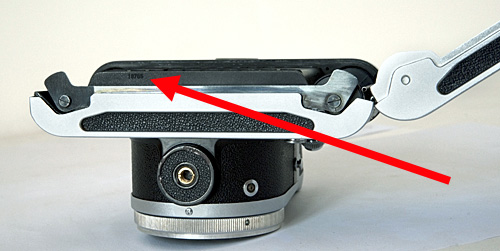 Praktisix [Prak_ser_no.jpg] |
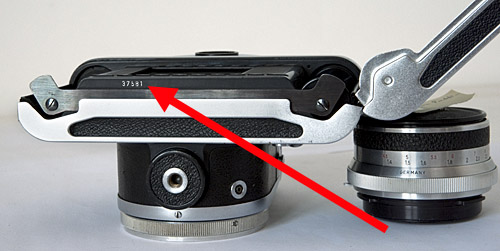 Praktisix II: number filled with white paint [Prak2_ser_no.jpg] |
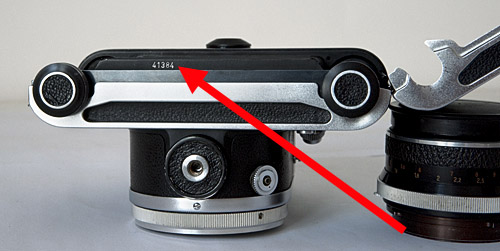 Praktisix IIA with serial number in white [Prak2A_ser_no.jpg] |
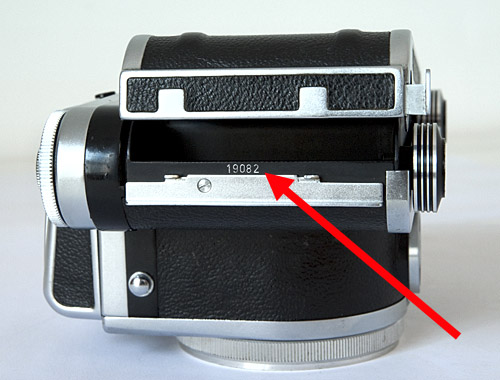 This is a Pentacon Six to which the letters “TL” have been added on the faceplate by the manufacturer. Serial number still in white. [pent6+tl_ser_no.jpg] |
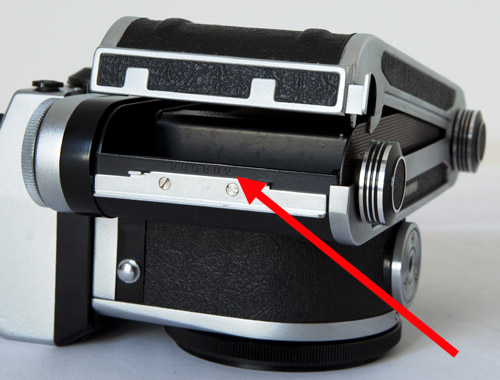 A late production Pentacon Six TL Note that the serial number is not filled with white paint, and so is harder to see. [pent6tl_ser_no.jpg] |
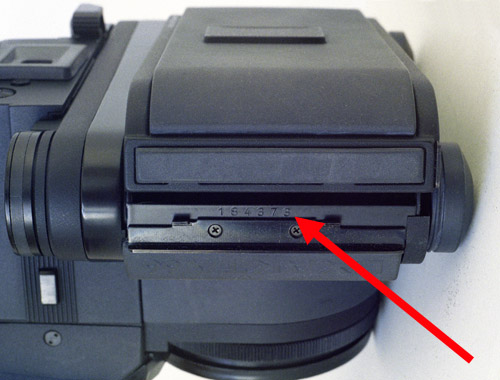 Exakta 66 Again, there is no white paint to highlight the number. [e66_ser_no.jpg] |
Note that, for reasons of security, serial numbers that are visible in photographs on this website have generally been changed by me on the computer. Collectors should therefore not base calculations on the numbers appearing here or elsewhere on this website. They are for illustrative purposes only.
Production Numbers
In his book “Spiegelreflexkameras aus
Dresden”, Richard Hummel gives the production numbers of
Medium Format SLR cameras (and indeed for other
cameras), according to the official State Yearbook of
the GDR. The data is on pages 157-160.
Gerhard Jehmlich quotes some of the same figures (p.
228), but only for the years 1964-1989. We are
interested in the years 1957 to 1990. Here is the
data from Hummel, to which I have added an additional
column with the cumulative total. All of these
cameras are the Praktisix, Praktisix II, Praktisix IIA,
Pentacon Six, Pentacon Six m, Hanimex Praktica 66,
Pentacon Six TLs, Pentacon Six TL-M and Pentacon Six
TL. Included in these numbers are also
the bodies that were supplied to West Germany for
conversion into the Exakta 66 Mk I – Mk III.
|
Year
|
Production
Number
|
Cumulative
Total
|
Year
|
Production
Number
|
Cumulative
Total
|
|
|
1957
|
2,150
|
2,150
|
1974
|
9,500
|
106,989
|
|
|
1958
|
3,882
|
6,032
|
1975
|
11,198
|
118,187
|
|
|
1959
|
4,163
|
10,195
|
1976
|
12,500
|
130,687
|
|
|
1960
|
104
|
10,299
|
1977
|
12,500
|
143,187
|
|
|
1961
|
1,399
|
11,698
|
1978
|
12,700
|
155,887
|
|
|
1962
|
3,445
|
15,143
|
1979
|
12,774
|
168,661
|
|
|
1963
|
4,750
|
19,893
|
1980
|
11,600
|
180,261
|
|
|
1964
|
4,407
|
24,300
|
1981
|
6,705
|
186,966
|
|
|
1965
|
3,530
|
27,830
|
1982
|
6,554
|
193,520
|
|
|
1966
|
4,461
|
32,291
|
1983
|
7,018
|
200,538
|
|
|
1967
|
3,500
|
35,791
|
1984
|
7,000
|
207,538
|
|
|
1968
|
9,100
|
44,891
|
1985
|
6,000
|
213,538
|
|
|
1969
|
10,000
|
54,891
|
1986
|
5,780
|
219,318
|
|
|
1970
|
11,558
|
66,449
|
1987
|
4,590
|
223,908
|
|
|
1971
|
12,547
|
78,996
|
1988
|
3,740
|
227,648
|
|
|
1972
|
9,993
|
88,989
|
1989
|
4,479
|
232,127
|
|
|
1973
|
8,500
|
97,489
|
1990
|
3,100
|
235,227
|
Other medium format SLRs
According to Hummel (p 158), 350 6 × 6 SLRs were produced in 1951. On page 134 he states that these were a pilot production of a modified version of the 1939 Exakta 66. On page 120 he states that about 2,500 Meister Korelles were produced “between 1947 and 1952”, but these are not indicated in any of the figures that he gives for medium format SLR production between those dates in his table 216 on page 158.
His figures also indicate that 118 6 × 6 SLRs were produced in 1953, and 2,250 in 1954. These must be the short-lived vertical Exakta 66 of the 1950s.
Are these Production Numbers reliable?
The opinions of
collectors on this are divided. Hummel himself
writes (p. 157), “Trotz aller Sorgfalt sind im
rechtlichen Sinn alle Zahlangaben der Produktionsdauer
und der Produktionsstückzahlen als Angaben ohne Gewähr
zu betrachten.”
My
translation: “In spite of all the care that has
been taken, in a legal sense the accuracy of all the
figures of statistical information and production
periods is to be viewed as not guaranteed.” The
table can therefore only be viewed as an approximate
guide.
According to the same source, no 6 × 6 SLRs were produced in 1955 and 1956, with Medium Format SLR production re-commencing in 1957. This was the Praktisix, and thereafter the only Medium Format SLRs produced in the GDR were the Praktisix (in its various versions), the Pentacon Six and the Pentacon Six TL. (Prototypes of the Praktisix were produced in 1956, but these were not for sale to the public, and therefore not listed in the figures.)
Hummel states on
page 153 that in November 1988 the 200,000th camera of
the Pentacon Six type left the factory. Serial
number evidence indicates that this is in fact
probably accurate, with the highest serial number at
the end of production two years later probably being
in the 206 (or 207?) thousands.
| In
support of the statistics
Some of those who research into the history of Pentacon cameras consider that these figures are likely to be reliable. One collector summarised their conclusions as follows: “We generally came to the conclusion the production numbers were not faked. The numbers simply vary too much and also went up as well as down from year to year. And, the discrepancy between production numbers and serial numbers is very low, about 3000 (actually less). With a total of around 206,000 [Pentacon Six] cameras produced, this is a discrepancy of only 1.5%. Finally, I have not seen all serial numbers. Possibly, the discrepancy is even lower.” (private correspondence to me) |
Skepticism
concerning the statistics
Others are much more
skeptical. Another extremely
well-informed collector wrote to me: “Die
Stückzahlen bei Hummel sehe ich (und auch
viele andere Sammler) immer sehr skeptisch,
sie sind kaum als Referenz zu verwenden, a)
weil Hummel die Jahrbücher der DDR
herangezogen hat und die waren fast immer
"geschönt" und b) weil er so viele Kameras in
seinem Buch erwähnt hat, die es definitiv
nicht gegeben hat, beispielsweise PENTINA 1.”
|
My opinion
My own opinion is that it must be borne in mind that these figures are from the official GDR State Statistical Yearbook, so two factors can have led to inaccuracy:
1) In the centrally-planned economy of the communist régime, all factories were given target production numbers, and failure to meet those numbers could lead to serious consequences up to and including imprisonment for staff deemed to have failed (or “sabotaged production”, in the politically-charged terminology of the dictatorship). It would therefore not be surprising if some mis-reporting took place in the submission of figures to the organs of the State.However, we have three sources for Praktisix / Pentacon Six / Exakta 66 (etc) serial numbers:
2) The East German State waged an incessant propaganda war against the rest of the world, based largely on exaggeration, lies and falsified statistics, so at this point, too, figures are likely to have been deliberately inflated.
- Hummel’s figures
- records of numbers built up by collectors, mostly in Germany and the UK
- a very large database of serial numbers from the principal UK repairer of these cameras.
Rejects
As with any complex manufacturing process at the end of which there is quality control, some cameras will have been rejected. (Incidentally, this did not appear to happen in the Soviet Union, with very many faulty cameras finding their way into shops and even being sold!) The same collector says:
“The Praktisix/Pentacon six is a very complex camera with several hundred individual components. Though I guess there were several unit tests along the way, some faults could only be tested in the final product. If a camera was found faulty in the final production test and it was scrapped, the serial number was very probably not reused and the part of the camera with the serial number was not recovered either. A yield loss of maybe 2% in the final test would probably be fully acceptable with this camera. i.e. the serial numbers may be slightly higher than the production numbers.”
Serial Numbers and Dating
It must be emphasised that the numbers in the above table are production numbers, not serial numbers. The highest serial number for a Pentacon Six TL is somewhere between 206 thousand+ and 207 thousand+ We will try to achieve more accurate serial numbers and dates below.
Two factors affect the relationship between serial numbers and dates of manufacture:
- Manufacturers do not generally start their first production run of a product with serial number 0001;
- When the changeover was made from the Praktisix IIA to the Pentacon Six, Pentacon re-started the counter, though again, not at 0001.
“KW/Pentacon followed different schemes for different products revising these with the years. For instance, the Praktinas started with serial 20001, with the prototypes in a separate three digit system. The Praktisix serial numbers started with 10001, with the prototype bodies serial numbers embedded in the production serials. Prototype Praktisix bodies had one serial number - the regular production number, while prototypes of the II and IIA had prototype numbers in addition to the regular production numbers. Prototype II and IIA bodies both have serials late in the Praktisix (I) range - around 1964. The serial numbers were continued with Praktisix II and IIA, but with the introduction of the Pentacon six, the serial numbers were set back to a lower number.” [TRA: probably 501].
Armed with this information, we can attempt to correlate serial numbers to years, but this is dependent on calculations based on information available at the time of writing. At a future date, new information may appear that will result in the need to revise these calculations.
Note that because Pentacon Six serial numbers started at a low number and extended beyond 200,000, there are Praktisixes with the same serial number as Pentacon Sixes, but as these are essentially two different cameras, this does not cause problems. (There are too many technical differences for a Praktisix to be converted to a Pentacon Six.)
Assumption 1
I assume that on average over the years 2% more cameras were made (and therefore received a serial number) than appeared in the Production Numbers summary given in the GDR Yearbook as quoted by Hummel.
Praktisix Models
|
Year
|
Production
Number passing inspection
|
Production
Number + 2% for rejects
|
Serial No
start
|
Serial No
end
|
Cumulative
Total passing inspection
|
Camera name
|
Earliest
known Ser No (1)
|
Latest known
Ser No (1)
|
|
|
1957
|
2,150
|
2,193
|
10001
|
12193
|
2,150
|
Praktisix
|
10041
|
33256
|
|
|
1958
|
3,882
|
3,960
|
12194
|
16153
|
6,032
|
||||
|
1959
|
4,163
|
4,246
|
16154
|
20399
|
10,195
|
||||
|
1960
|
104
|
106
|
20400
|
20505
|
10,299
|
||||
|
1961
|
1,399
|
1,427
|
20506
|
21932
|
11,698
|
||||
|
1962
|
3,445
|
3,514
|
21933
|
25446
|
15,143
|
||||
|
1963
|
4,750
|
4,845
|
25447
|
30291
|
19,893
|
||||
|
1964
|
4,407
|
4,495
|
30292
|
34786
|
24,300
|
Praktisix
II
|
33603
|
40486
|
|
|
1965
|
3,530
|
3,601
|
34787
|
38387
|
27,830
|
||||
|
1966
|
4,461
|
4,550
|
38388
|
42937 (3)
|
32,291
|
Praktisix IIA
|
39214 (2)
|
42698 (3)
|
Notes
(1) The earliest and latest known serial numbers are based on data gathered by collectors (mostly in Germany and the UK) and on a large database of the repair and service records of the principal UK repairer of these cameras. While the work done has been thorough, inevitably the data available is incomplete.
(2) The
transition from the Praktisix II to the Praktisix IIA
seems to have been gradual. Perhaps there was a
time in the factory when both models were being
completed. Thus it is not a great surprise that
there is an “overlap” of serial numbers, with some
Praktisix II cameras with a slightly higher serial
number than the lowest-numbered Praktisix IIA cameras.
(3) In
January 2020 I received a report of a Praktisix IIA with
the serial number 43569. This is just 632 higher
than the final serial number that we had calculated on
the basis of the evidence then available and the
assumptions indicated on this page. This is a
deviation of less than 1.5% from our calculations.
It therefore seems likely that the number in the camera
seen is genuine and that our calculations are extremely
close to the actual numbers.
Assumption 2
Our collector writes, “When the Pentacon six was started, they didn’t wait for New Year to begin production! So there is a gap between Praktisix IIA and Pentacon six production numbers.”
In my calculations I assumed that 235
of the medium format SLRs produced at the end of 1966
were Pentacon Sixes. This would change the
final line of the above table, reducing the numbers of
Praktisix IIA cameras by 235, as shown in the following
table:
|
Year
|
Production
Number passing inspection
|
Production
Number + 2% for rejects
|
Serial No
start
|
Serial No
end
|
Cumulative
Total passing insepction
|
Camera name
|
Earliest
known Ser No
|
Latest known
Ser No
|
|
|
1966
|
4,226
|
4,311
|
38388
|
42698
|
32,061
|
Praktisix IIA
|
39214
|
42698
|
In the light of the
discovery in 2020 of a Praktisix IIA with the serial
number 43569, a slight upwards adjustment of these
figures appears to be necessary.
Assumption 3
There are reports of a Pentacon Six being offered with a serial number in the five hundreds. I will therefore also assume that the starting serial number for the Pentacon Six was 501. These assumptions yield the following table:
Pentacon Six & Pentacon Six TL, and cameras derived from them
|
Year
|
Production
Number passing inspection
|
Production
Number + 2% for rejects
|
Serial No
start
|
Serial No
end
|
Cumulative
Total passing inspection
|
Camera name
|
Earliest
known Ser No
|
Latest known
Ser No
|
|
|
1966
|
235
|
240
|
501
|
740
|
32,291
|
Pentacon Six
|
1118
|
23859 (1)
|
|
| 1967 |
3,500
|
3,570
|
741
|
4310
|
35,791
|
||||
|
1968
|
9,100
|
9,282
|
4311
|
13592
|
44,891
|
Includes
some of the Pentacon Six cameras
relabelled Six TL (2)
|
12793
|
19028
|
|
|
1969
|
10,000
|
10,200
|
13593
|
23792
|
54,891
|
Pentacon Six TL
|
12794 (3)
|
206478
|
|
|
1970
|
11,558
|
11,789
|
23793
|
35581
|
66,449
|
Hanimex
Praktica 66
|
20433*
|
22980
|
|
|
1971
|
12,547
|
12,798
|
35582
|
48379
|
78,996
|
||||
|
1972
|
9,993
|
10,193
|
48380
|
58572
|
88,989
|
||||
|
1973
|
8,500
|
8,670
|
58573
|
67242
|
97,489
|
||||
|
1974
|
9,500
|
9,690
|
67243
|
76932
|
106,989
|
||||
|
1975
|
11,198
|
11,422
|
76933
|
88354
|
118,187
|
||||
|
1976
|
12,500
|
12,750
|
88355
|
101104
|
130,687
|
||||
|
1977
|
12,500
|
12,750
|
101105
|
113854
|
143,187
|
||||
|
1978
|
12,700
|
12,954
|
113855
|
126808
|
155,887
|
||||
|
1979
|
12,774
|
13,029
|
126809
|
139837
|
168,661
|
||||
|
1980
|
11,600
|
11,832
|
139838
|
151669
|
180,261
|
||||
|
1981
|
6,705
|
6,839
|
151670
|
158508
|
186,966
|
||||
|
1982
|
6,554
|
6,685
|
158509
|
165193
|
193,520
|
||||
|
1983
|
7,018
|
7,158
|
165194
|
172351
|
200,538
|
||||
|
1984
|
7,000
|
7,140
|
172352
|
179491
|
207,538
|
||||
|
1985
|
6,000
|
6,120
|
179492
|
185611
|
213,538
|
||||
|
1986
|
5,780
|
5,896
|
185612
|
191507
|
219,318
|
||||
|
1987
|
4,590
|
4,682
|
191508
|
196189
|
223,908
|
||||
|
1988
|
3,740
|
3,815
|
196190
|
200004
|
227,648
|
||||
|
1989
|
4,479
|
4,569
|
200005
|
204573
|
232,127
|
||||
|
1990
|
3,100
|
3,162
|
204574
|
207735
|
235,227
|
*Other known Hanimex
Praktica 66 serial numbers: 20454, 20552, 20566.
See also below.
Notes
(1) In November 1983 a Pentacon Six with the serial number 32649 was received for repair. The production number evidence given above would lead one to suppose that this body was produced in 1970, at which time all bodies should have been receiving a Pentacon Six TL face plate. One must assume that this body (and perhaps others from the same batch) had left-over Pentacon Six (non TL) face-plates applied to them. In the GDR, where the first post-war Contax S cameras had left the factory without the delayed-action lever because of a lack of parts (see details here), and where throughout its history there were shortages of virtually everything, one should not be surprised if older stocks of parts that came to light were not simply thrown away, but used even when perhaps they should not have been.
(2) Some cameras manufactured in 1969 also had “Pentacon Six” faceplates to which “TL” had subsequently been added on the line below during the manufacturing process.
(3) It is difficult to determine with certainty the earliest genuine Pentacon Six TL serial number, as there is documentary evidence that a number of Pentacon Sixes have been upgraded by replacing the original front plate with a TL front plate. It is almost certain that official distributors, such as CZ Scientific Instruments in the UK, would not have done this, but many independent repairers had spare parts from the factory and some are known to have upgraded Pentacon Six cameras to the Pentacon Six TL specification. Thus, a body with serial no 4066, which was almost certainly produced in 1967, was received for repair in November 1985 with a Pentacon Six TL face plate. It is not possible to see how this could have been fitted to the camera during the manufacturing process.
One must ask whether the same applies to body 7303, which was received for repair in January 1985 with a Pentacon Six TL face plate. This camera was apparently manufactured in the middle of the 1968 production run. Perhaps the body was not completed in the correct sequence, and thus a Pentacon Six TL face plate was applied to it.
Body number 12794 is referred to in the table above. After that body, the next numbers in our database of Pentacon Sixes repaired in the UK are all in the eighteen thousand nine hundreds: 18948, 18961, 18974, 18993, then into the nineteen thousands.
One must also bear in mind that batches of cameras were sent to different countries, which may account for the “clustering” of numbers (groups of numbers that are near each other) in any given market, and for “gaps” in the sequences of numbers recorded in any given market.
The above table reflects the currently available data. It results in the Pentacon Six with the serial number 200,000 being produced in 1988, as reported by Hummel. If we include the various models of the Praktisix, total production numbers that left the factory are higher. If production started with serial number 501, the 200,000th Pentacon Six camera would not have been produced until early 1989, even though the camera with serial number 200,000 would have been produced towards the end of the production run in 1988. Reject numbers will inevitably not have been an exact 2% every year, even if this was the average, so that would introduce a slight variation. There is also evidence that a Pentacon Six TL with the serial number 200,8xx was available for sale new in a camera shop in East Germany in May 1989, which indicates that the above table is reasonably accurate.
|
With such reconstructions from
incomplete data, it is impossible to guarantee
absolute accuracy. However, the above
table should enable you to date your camera
within a margin of accuracy of + one
year. |
Other cameras
using a Pentacon six chassis
|
Camera name
|
Earliest
known Ser No
|
Latest known
Ser No
|
|
Hanimex
Praktica 66
|
204331
|
22980
|
|
Pentacon Six
TLs
|
168272
|
175314
|
|
Exakta 66
|
177298
|
182858
|
|
Exakta 66 Mk II
|
176907
|
188521
|
|
Exakta 66 Mk
III
|
180478
|
184566
|
Notes
Hanimex Praktica 66
1The lowest serial number previously reported to me was 20454, but in May 2023 I have received a photograph of the serial number of one of these cameras with the number 20433. My thanks to the owner in the USA.
It appears that the cameras that were labelled “Hanimex Praktica 66” were taken from the 1969 production run of the Pentacon Six TL.
Pentacon Six TLs
On the basis of the information currently available, the Pentacon Six TLs was modified from Pentacon Six TL cameras manufactured in 1983 and 1984.
Exakta 66
(1984-2000)
The Pentacon Six bodies used to make the
Exakta 66 (1984-2000) were taken from regular Pentacon
Six TL body production at different dates, but when they
were completed in (the then) West Germany, this was not
done in “first in, first out” (or serial number)
order. So, for instance, Mk III bodies for which
data is known have lower serial numbers
than one Mk II body for which we have the serial
number. The situation may also be complicated by
the fact that some Mk I or Mk II bodies have been
subsequently upgraded to Mk III specification (and
labelling), without, of course, any change of serial
number. On the basis of the above tables, most
bodies for the Exakta 66 were from Pentacon’s 1985
production and some from the 1986 production, which ties
in well with other information on Exakta 66
availability. Bodies were then finished as Exakta
66 cameras, although stock was not used in serial number
order.
To go to the Bibliography, click here.
To go on to the next section, click
below.
38 Disclaimer
To go to the beginning of the history section, click here.
To go to introduction to the cameras, click here.
To choose other options, click below.
Home
© TRA August 2010 Latest revision:
May 2023